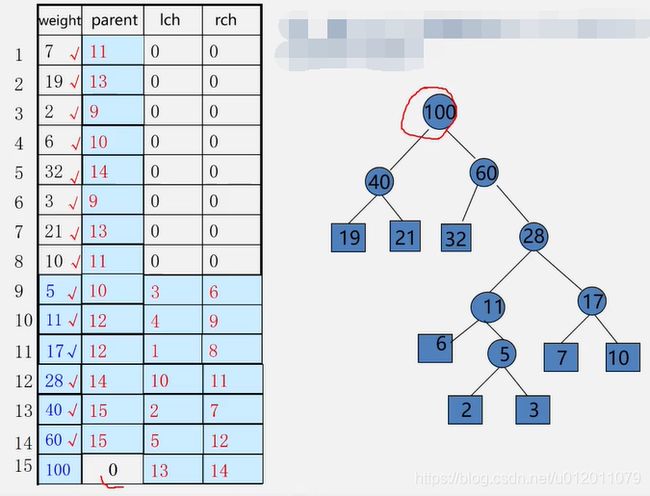C++哈夫曼树+哈夫曼编码的实现(双完整版)
注释详解哈夫曼Tree和哈夫曼Code
- 一、哈夫曼Tree
- 二、哈夫曼Code
本文是根据B站视频青岛大学 - 王卓老师的数据结构来实现的,涉及到哈夫曼Tree 和 哈夫曼Code的C++版完整实现,若有不足欢迎大佬斧正-(/▽\)

一、哈夫曼Tree
具体理论请配合B站视频来学习,构造哈夫曼Tree主要的方法如下:
第一步:构造森林全是根
第二步:选用两小造新树
第三步:删除两小添新人(parent设置为 n+1 到 2n-1 中的下标)
第四步:重复2、3步剩单根
话不多说,我们只需要记住这四步,把下面代码的框架敲熟了,就能运用自如了。
PS:代码有详细注解 和 引导思考,喜欢的话可以收藏一波~
#include 我们可以对应下面这张图来看代码,弄懂思路。

Input
please input the number of nodes: 7
please input the weight of nodes:
7
19
2
6
32
3
21
Output
index weight parent LTree RTree
1 7 0 0 0
2 19 11 0 0
3 2 8 0 0
4 6 9 0 0
5 32 12 0 0
6 3 8 0 0
7 21 12 0 0
8 5 9 3 6
9 11 10 8 4
10 18 11 1 9
11 37 13 10 2
12 53 13 7 5
13 90 0 11 12
二、哈夫曼Code
该代码在实现哈夫曼编码核心算法时既使用了C++的string类来实现,也使用了C的方式实现。这是在学会构造哈夫曼树之后的进一步提升,在这里给需要提高的同学抛出一个思考问题,“C++如何处理模板类template实现自动根据用户输入的 weight 值类型来分配内存”。
![]()
首先先看图,根据图来实现以下步骤(用char动态数组):
第一步:构建哈夫曼树表、HC表(动态二维数组)、cd表(一维)
第二步:一般规定左子树路径为0,右子树路径为1,按哈夫曼树表寻找parent结点直到为0。
与第二步同时进行:先将临时cd表最后一个元素定为’\0’,创建临时结点记录当前处理的结点。
第三步:将cd表值赋值给HC表,同时销毁cd表的临时内存。
在这里插入代码片
```cpp
#include Input
please intput the number of vertice: 7
what value do you want to give them?
0.4
0.3
0.15
0.05
0.04
0.03
0.03
Output
index HC[i]
1 0
2 10
3 110
4 11111
5 11110
6 11100
7 11101
路曼曼其修远兮,吾将上下而求索